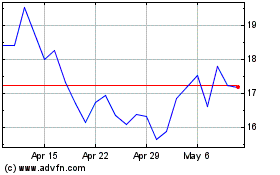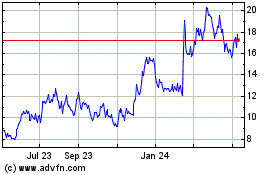Uber's Speed Could Limit Lyft -- Heard on the Street
May 05 2021 - 8:10PM
Dow Jones News
By Laura Forman
The great ride-share recovery is no freeway.
Shares of ride-hailing companies fell Wednesday following Lyft's
first-quarter report and went even lower after hours on Uber's
earnings release that came 24 hours later. Uber said its full
ride-share recovery in places like Australia and Hong Kong has been
offset to some degree by continued weakness in places like India
and Brazil, where Covid-19 case counts remain high. Meanwhile Lyft,
which operates the majority of its business in the U.S., says its
ride-share ride recovery peaked in March, at least temporarily,
with volumes declining month over month in April as demand
outstripped supply.
On an earnings call Wednesday, Uber chief executive Dara
Khosrowshahi said the two factors determining driver supply are
safety and earnings opportunities. The company's focus on the
latter, in particular, might have given it a leg up versus its U.S.
competitor recently.
Lyft continues to forecast that it will turn profitable in the
third quarter this year on the basis of adjusted earnings before
interest, taxes, depreciation and amortization. But that forecast
assumes a higher volume of rides and more rational pricing to the
rider.
To get there, Lyft has been offering incentives to drivers
through higher pay and bonuses in some cases, but it also seems to
think its supply problem will naturally sort itself out to some
degree. The company cites less government aid, more vaccines,
historically superior economics relative to food-delivery driving
and the desire for meaningful social interactions as several
factors that should attract gig-economy drivers back to its
platform.
Uber also stands to benefit from all of those factors and
already seems to be seeing some of their effects. On Wednesday, the
company said its own U.S. mobility bookings recovery picked up the
pace in April on a sequential monthly basis. Even though ride-share
drivers commonly "double app," incentives can lead drivers to pick
up rides from one platform more frequently than others. The
Rideshare Guy recently cited an Uber promotion offering an extra
$100 for a driver who completes three trips in a week. With both
Uber and Lyft saying this week that their drivers are making up to
$30 to $40 an hour in some U.S. cities, $100 is a significant
bonus.
AB Bernstein's Mark Shmulik suggests Uber's aggressive driver
incentives could be leading to shorter wait times and lower
consumer fares compared to Lyft. He also notes the popularity of
its membership program, Uber Pass, which includes Uber Eats, means
riders might be more likely to open Uber's app first and book
without even opening up Lyft to compare, assuming Uber's wait time
and pricing are acceptable.
New data from Edison Trends suggest Uber's more recent recovery
in the U.S. could be coming at Lyft's expense. Consumer spending on
Uber, for example, hit a new post-Covid high the week of April 26,
the data show, while Lyft's post-Covid consumer spending peaked
mid-March and has since fallen. According to Edison Trends, in the
week of April 27 last year, Lyft riders spent 57% as much as Uber
riders. In the corresponding week this year, that figure dropped to
44%.
That isn't to say all is good for Uber. Global rides revenue
missed Wall Street's forecast by a sizable margin, even excluding a
$600 million accrual related to driver classification in the U.K.
Still, thanks to continued strength in its Eats business, the
company also said April was its strongest month ever in terms of
overall gross bookings, while last week was its best week ever.
Lyft investors betting on recovery momentum might want to switch
lanes.
Write to Laura Forman at laura.forman@wsj.com
(END) Dow Jones Newswires
May 05, 2021 19:55 ET (23:55 GMT)
Copyright (c) 2021 Dow Jones & Company, Inc.
Lyft (NASDAQ:LYFT)
Historical Stock Chart
From Mar 2024 to Apr 2024

Lyft (NASDAQ:LYFT)
Historical Stock Chart
From Apr 2023 to Apr 2024
